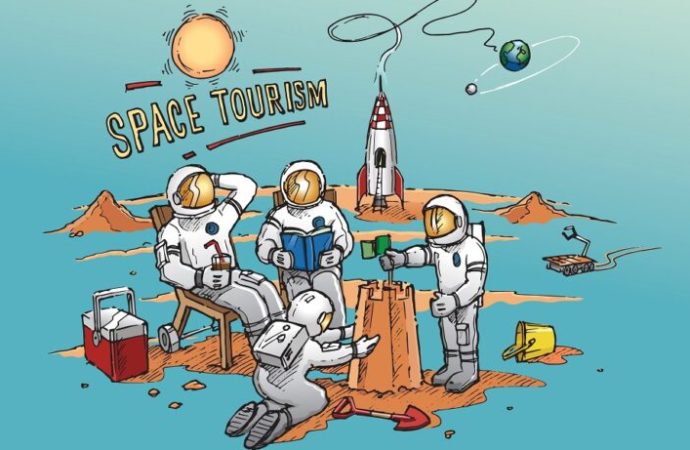As technology advances and our understanding of space deepens, the concept of space tourism is transitioning from science fiction to reality. This emerging industry holds the promise of not only making space accessible to a broader audience but also stimulating economic growth, inspiring future generations, and fostering international cooperation in space exploration. In this article,
As technology advances and our understanding of space deepens, the concept of space tourism is transitioning from science fiction to reality. This emerging industry holds the promise of not only making space accessible to a broader audience but also stimulating economic growth, inspiring future generations, and fostering international cooperation in space exploration. In this article, we will explore the future of space tourism, examining its benefits, case studies, and examples that illustrate its potential.
What is Space Tourism?
Space tourism refers to the commercial activity of sending private individuals into space for recreational, leisure, or adventure purposes. It encompasses a range of experiences, from suborbital flights that provide a brief taste of weightlessness to orbital flights that allow passengers to spend extended time aboard a spacecraft or space station. The industry aims to offer ordinary people the chance to experience the wonders of space, much like how commercial airlines opened the skies to millions.
Benefits of Space Tourism
1. Economic Growth
One of the most significant benefits of space tourism is its potential to stimulate economic growth. The industry is expected to generate billions of dollars in revenue, creating jobs in various sectors, including aerospace, hospitality, and technology. According to a report by the Space Foundation, the global space economy was valued at $423 billion in 2019 and is projected to reach $1 trillion by 2040, with space tourism playing a crucial role in this growth.
2. Technological Advancements

Image by Yandex.com
The pursuit of space tourism is likely to drive innovation in technology. Companies involved in the industry are developing advanced spacecraft, propulsion systems, and life-support technologies, which could have applications beyond space travel. For instance, advancements in reusable rocket technology, pioneered by companies like SpaceX, not only reduce the cost of space travel but also benefit satellite deployment and cargo transportation.
3. Environmental Awareness
Space tourism can also foster greater environmental awareness. As tourists venture into space, witnessing Earth from above, they may gain a renewed appreciation for the planet’s fragility. This perspective can inspire individuals to advocate for environmental conservation and sustainability. Initiatives like the Overview Effect, where astronauts report a profound emotional response to seeing Earth from space, highlight the potential for space tourism to promote ecological responsibility.
4. Inspiration and Education
Space tourism offers an opportunity to inspire future generations. By making space accessible to civilians, it encourages interest in science, technology, engineering, and mathematics (STEM) fields. Educational programs associated with space tourism can provide hands-on experiences that ignite curiosity and motivate young minds to pursue careers in space exploration and related disciplines.
Case Studies and Examples
1. Virgin Galactic
Virgin Galactic, founded by Sir Richard Branson, is one of the pioneers in the space tourism industry. The company aims to provide suborbital flights to paying customers aboard its SpaceShipTwo spacecraft. In July 2021, Branson and a crew of five successfully completed a test flight, marking a significant milestone for commercial space tourism. The company has already sold hundreds of tickets, priced at approximately $250,000 each, and plans to begin regular flights in the near future. Virgin Galactic’s success could pave the way for other companies to enter the market, further driving the growth of space tourism.
2. Blue Origin
Founded by Amazon’s Jeff Bezos, Blue Origin aims to democratize space access through its New Shepard rocket system. In July 2021, Blue Origin conducted its first crewed flight, carrying Bezos and three other passengers, including aviation pioneer Wally Funk. The New Shepard rocket provides suborbital experiences, allowing passengers to experience a few minutes of weightlessness and a view of Earth from above. Blue Origin’s successful flights demonstrate the feasibility of commercial space travel and have garnered significant public interest in space tourism.
3. SpaceX

Image by Yandex.com
SpaceX, led by Elon Musk, is revolutionizing space travel with its ambitious plans for human spaceflight. The company has made headlines for its crewed missions to the International Space Station (ISS) and its vision of colonizing Mars. SpaceX’s Crew Dragon spacecraft is designed for both government and commercial missions, including potential space tourism. In September 2021, SpaceX launched the Inspiration4 mission, which sent an all-civilian crew on a three-day orbital flight. This groundbreaking mission raised $200 million for St. Jude Children’s Research Hospital and showcased the possibilities of space tourism for philanthropic endeavors.
4. Axiom Space
Axiom Space is focused on building the world’s first commercial space station, aiming to host tourists, researchers, and professionals in low Earth orbit. The company plans to offer trips to the International Space Station as a precursor to its own facility. Axiom’s approach highlights the potential for space tourism to support scientific research and foster international collaboration in space exploration. Their vision includes creating a sustainable habitat for future generations to live and work in space.
The Road Ahead
While space tourism holds great promise, several challenges must be addressed to ensure its sustainable growth. These include:
1. Safety and Regulation
Safety is paramount in space travel. The industry must establish rigorous safety standards and regulatory frameworks to protect passengers. Government agencies like the Federal Aviation Administration (FAA) in the United States play a crucial role in overseeing commercial spaceflight operations, ensuring that companies adhere to safety protocols.
2. Cost Accessibility
Currently, the cost of space tourism remains prohibitively high for most people. While prices are expected to decrease as technology advances and competition increases, it will take time for space travel to become accessible to the general public. Innovative business models, such as fractional ownership or sponsorship programs, could help democratize access to space experiences.
3. Environmental Concerns
The environmental impact of space tourism is a growing concern. Rocket launches produce greenhouse gas emissions and contribute to atmospheric pollution. As the industry evolves, there will be a need for sustainable practices, including the development of eco-friendly propulsion systems and strategies to minimize the environmental footprint of space travel.
Conclusion
A fascinating new development in the history of human exploration is space tourism. The potential of this industry is enormous, with substantial advantages ranging from technological improvements and economic growth to raising environmental consciousness and motivating future generations. Leading the way are businesses like Virgin Galactic, Blue Origin, SpaceX, and Axiom Space, which are capturing the public’s interest and demonstrating the viability of commercial space travel.
To guarantee that space tourism grows in a sustainable and inclusive manner, we must carefully handle the obstacles that lie ahead. Many people’s goal of visiting space may soon come true with sustained innovation, teamwork, and a dedication to environmental responsibility and safety. There are countless opportunities as we travel beyond Earth, and space tourism has a promising future.
FAQs
1. What is the cost of a ticket for space tourism?
The cost of a ticket for space tourism varies significantly depending on the company and the type of experience offered. For example, Virgin Galactic tickets are priced at approximately $250,000 per person for a suborbital flight, while SpaceX’s orbital flights can cost several million dollars per seat. As the industry matures and competition increases, prices are expected to decrease, making space travel more accessible.
2. How long do space tourism flights last?
Space tourism flights can vary in duration depending on the type of experience. Suborbital flights, such as those offered by Virgin Galactic and Blue Origin, typically last around 10 to 15 minutes, with a few minutes spent in weightlessness at the peak of the flight. In contrast, orbital flights, like SpaceX’s Crew Dragon missions, can last from a few days to several weeks, allowing passengers to experience life in space for an extended period.
3. What safety measures are in place for space tourism?
Safety is a top priority in the space tourism industry. Companies must adhere to strict safety standards and regulations set by government agencies, such as the Federal Aviation Administration (FAA) in the United States. This includes rigorous testing of spacecraft, comprehensive training for crew members and passengers, and thorough safety briefings. Additionally, many companies have invested in redundancy systems and fail-safes to mitigate risks during flight.
4. Can anyone go on a space tourism flight?
While the prospect of space tourism is exciting, there are some restrictions. Most companies require passengers to meet specific health and fitness criteria and undergo medical evaluations. Additionally, participants must be at least 18 years old, though some companies may allow minors to fly with parental consent. It’s essential for potential tourists to check the specific requirements of each space tourism provider before booking a flight.
5. What experiences can passengers expect during a space tourism flight?
Passengers on a space tourism flight can expect a unique and exhilarating experience. For suborbital flights, passengers will experience a brief period of weightlessness, allowing them to float freely in the cabin and view Earth from a high altitude. During orbital flights, passengers can enjoy stunning views of Earth, participate in scientific experiments, and experience the sensation of microgravity over an extended period. Many companies also provide immersive pre-flight training to prepare passengers for the unique environment of space.
















